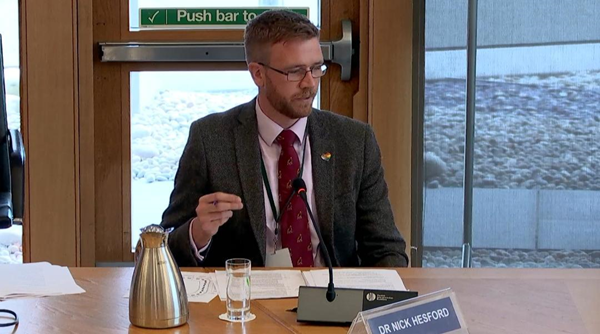
On Wednesday 21 June, our Scottish Head of Policy, Ross MacLeod, and Scottish Advisor, Dr Nick Hesford gave expert evidence to the Rural Affairs and Islands Committee as they debated the Wildlife Management and Muirburn (Scotland) Bill.
Following a broad discussion of a potential licensing scheme for grouse moors, the second session focused on the issue of prescribed burning, particularly on peatland. Challenging contrary claims from other participants, Nick was unequivocal in his statement of support for burning, making it clear that “there is no consensus that burning is damaging to peatlands and, if anything, the most robust science suggests that actually there are positive impacts of burning on peatlands.”
Nick also highlighted the need to take long-term studies into account when looking at the impacts of burning: “If you start to look at long-term studies looking at burning over the actual real term period of a burning cycle, you start to see that over time you actually get ecosystem service benefits.” He went on to highlight his concerns about the unforeseen impacts of the Bill, noting that "there is no provision in the bill to allow burning on peatland to deliver these ecosystem service benefits and that, I think, will tie the Scottish Government's hands in terms of what they can do to deliver on biodiversity and climate change."
There was also a heated debate around the importance of peat depth, with issues highlighted around a lack of a reliable register of depths across Scotland and the specifics around where you take the measurement from, with Nick suggesting the importance of it being at the ignition point. Ross Ewing, Director of Moorland at Scottish Land and Estates, expressed his reservation about the use of peat depth measurements, given the fact that prescribed ‘cool’ burns only burn the surface flora. Making his views very clear, he said “it strikes me as very illogical to regulate an above-ground activity using a below-ground metric.”
This view was shared by Deputy Assistant Chief Officer Bruce Farquharson, the Wildfire Capability Lead at Scottish Fire and Rescue Service. “I think the differentiation in peat depth is, from my perspective, irrelevant and there is evidence that managed cool burns does not penetrate any more than a centimetre below the surface of peatland”, he stated. “My concern is if we restrict where muirburn can be carried out by bringing in a specified depth, then what we're doing is allowing a larger proportion of the fuel load to be unmanaged, and the very thing we're trying to prevent, which is damage to the peatlands, will, in fact, be at higher risk because a wildfire absolutely will damage the peatland.”
The 2018 fire on Saddleworth Moor was cited as a prime example of this. “Seven centimetres of peat were lost in that fire”, explained Ross Ewing. “It will apparently take 200 years to restore that peat and it released somewhere in the region between 17,798 and 26,281 tonnes of carbon dioxide equivalent from the soil carbon losses … we just need to remind ourselves about the role that burning can play when it comes to reducing fuel load because as far as I’m concerned it's fundamentally important.”
The counterpoint from Dr Emma Hinchcliffe of the IUCN UK Peatland Programme, supported by Duncan Orr-Ewing of RSPB Scotland, was that rewetting provided a solution and that restored habitats were more resilient to wildfire. While agreeing that rewetting had a part to play, Nick was quick to challenge its role as a single solution to wildfire.
“If you think that the science on muirburn and the environmental impacts is complex and requires more study, then there is even less science on rewetting and there is even less science on cutting. Rewetting, for example, poses an increased risk of methane emissions. Methane is 80 times more damaging in the climate context than carbon and so whilst I think that cutting and rewetting are important management tools, they shouldn't be prioritised.”
Bruce Farquharson agreed, stating that “rewetting is an important tool in the box, but it’s not the only tool in the box and perhaps not the most effective one.” Nick went on add that “if you've got a wildfire, they probably happen in the summer where the water table, even the most ecologically intact and well-functioning bog, can drop by up to 30 centimetres. Just because a bog has been rewetted, it doesn't mean that it doesn't pose a risk to wildfire”.
The threat of wildfire was never far from the discussion, with Robbie Kernahan of NatureScot making it clear that “wildfire risk is heightened and is going to continue to heighten.” When asked by Rhoda Grant MSP about the best way to reduce wildfire risk, Bruce Farquharson was very clear. “In my opinion, and what I have seen when I've gone around the country and spoken with various people, muirburn is by far the most effective because it removes a fuel in its entirely. Cutting is effective to a point, but I use the analogy of attending a fire in the house of a hoarder rather than the house of a minimalist. Cutting would leave a dry layer that actually encourages the spread of fire. Muirburn is absolutely the most effective way of removing the fuel which prevents the wildfire from happening.”
You can watch the full debate here >